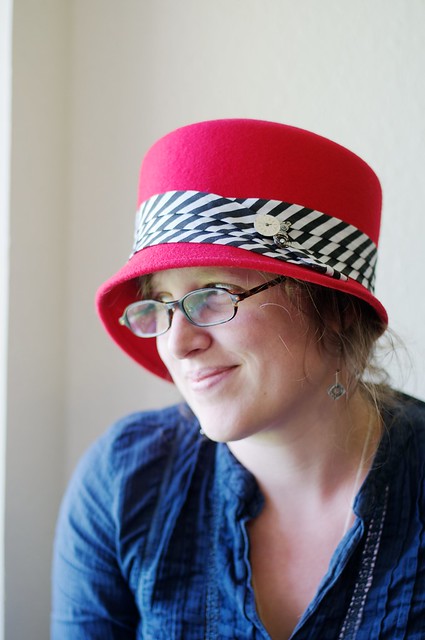As those who attended our wedding this summer may have noticed, I am a great proponent of hats. Hats (and I am talking about proper hats, not the baseball cap or similar creations) brighten the day as you pass them in the street.
Back in the day, when I was a conscientious member of environmental organisations, I opposed the culture that sets too great a store by clothing. I parroted the idea that it does not really matter how things look, as long as they wear well and keep you warm. Truth to tell, I never really believed it. It was only the only expression I had come across of an opposition to a fashion culture which was focused on intense consumerism. I wanted to object to the demand that one should wear clothes only because they were fashionable, and then throw them away in order to buy other clothes as soon as the fashion changed.
Bound up with this, I also objected to the idea of spending a lot of money on clothes. I took great pride in wearing jackets that cost 50 nok (about £5), and never having paid more than £20 for any other item of clothing. Again, this was to a great extent due to an impression that what cost money was the "newness" of the item of clothing. And to a certain extent that is true.
What my younger self disregarded, in part because I had not really had any real experience with shops that were not high street chains or charity shops, and in part because (I confess) of a propensity for binary thinking (good/bad, cheap/expensive), was the aesthetic experience of being surrounded by beautifully dressed people.
It has become increasingly clear to me that while my younger self was right to object to the homogenising evil that is consumer fashion culture, my reaction, which simply meant I inverted the values everyone around me seemed to use, rested on the fallacy that spending money on clothes or paying attention to one's sartorial choices is therefore inherently wrong. That conclusion completely ignored the importance of aesthetic experience as a way of making life worth living.
This is not a call for a dress code. Not primarily. Although, I cannot think of anything more depressing than all those people in the street wearing sweat pants (and
ugly sweatpants at that) as if it were the most natural thing in the world.* Think of how the sun starts shining and the birds sing happily as a well dressed man in a three piece suit and a hat walks by.
The primary problem with the clothes industry is twofold: it wants to dress everyone the same (welcome,
ennui; hello, people wearing clothes that do not suit them
at all), and it wants everyone to throw out their clothes as soon as they have bought them in order to make room for a new batch of profoundly unoriginal shit.
I am aware that this argument is heading towards the argument that if you buy more expensive clothes, then you will buy less and you are more likely to wear it for longer; not to mention the fact that the people making your clothes will generally be paid better, and the material will be more sustainable. But that was not the point I was trying to make. I was heading towards
hats.
Hats are a traditional, and wonderful, expression of individuality. The hats you wear, the way you wear them. They are not primarily
useful, as quite often they are too warm, and they will fly off in the wind if you are not careful; but they are stylish and lovely beyond words if the right hat is chosen and worn at the right angle. Because hats have dropped somewhat out of fashion, however, proper hat shops are becoming an increasingly rarer sight. There used to be one in Molde; there still is one in Trondheim, and another in Edinburgh. We should use them while we can. If we don't, we may have to rely on H&M or John Lewis for hats in the future.
Here is the hat I bought today:

I wear a hat now. Hats are cool.
I love it.
*This is of course a blatant lie. There are many more depressing things; first among them, half a million children starving to death in Somalia. You should of course go
donate to the famine relief effort before you spend any money on hats. My point is, rather, that the aesthetic experience is
also important, and it should not be neglected.

Comments